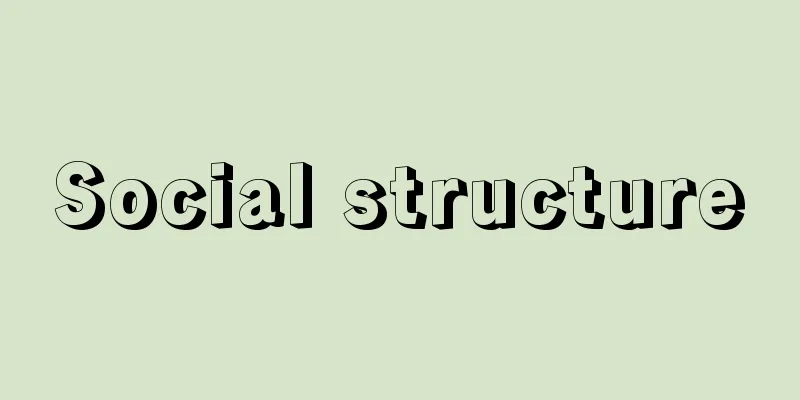Social structure

|
Although it may sometimes refer to the internal structure of a particular group (such as a family), it is usually the scope of self-sufficient life within which the main life needs of members are satisfied, that is, the comprehensive structure of the entire society. Since a structure is a regular pattern of mutual relations observed between components, social structure refers to a structured pattern of elements that has unity and continuity in a relative sense. In this case, the concept of social structure differs depending on what elements that make up a society are selected, which ones are focused on, and how the mutual relations between them are perceived. [Akira Hamashima] Sociological structural modelIn the early days of sociology, as seen in the social organism theory, it was thought that social structure is formed when each component is in a relationship of close interdependence through the principle of cooperation based on the division of labor (organism model). In cultural anthropology, Malinowski also viewed social structure as the functional interrelationships of institutions, and believed that economic, political, kinship, and educational institutions are organically related to each other to form a complex whole in the process of human beings satisfying their needs. Radcliffe Brown also believed that the functional unity of institutions guarantees the continuity and stability of social structure, and that the complex of social relations between people who occupy certain positions is nothing other than social structure. Nadel also considered social structure to be the orderly arrangement of social relations between individuals who fulfill related roles. Parsons, in particular, regarded the relatively constant elements as structures, and its substantial content as an integration of institutions or stable roles, arguing that the social structure (= social system) is an equilibrium system resulting from the institutionalization of each element (particularly roles), and that this equilibrium is maintained by the institutionalization and internalization of common values and norms, the fulfillment of roles based on those values, the preparation of the conditions necessary for fulfilling those roles (allocation of personnel, tools, power, rewards, prestige, etc.), and socialization and social control that accompany motivation to conform and the suppression of deviation. In this so-called equilibrium (integration) model, social structure refers to a state in which personnel and property are relatively stably and sustainably allocated to a system of roles and statuses by institutionalized norms. Of course, such a structure can maintain equilibrium because each element performs its own function and contributes to the survival of the whole, but Parsons argued that such functional requirements are divided into relatively independent subsystems or functional sectors, such as Adaptation (adaptation → economy), Goal-attainment (goal achievement → politics), Integration (integration → social control), and Latency (maintenance of latent patterns → culture and motivation), and that the equilibrium of the social structure (= social system) is maintained by mutual exchange of outputs (input-output) between these sectors (AGIL diagram). This equilibrium is constantly threatened by changes in the elements, and it is necessary to correct the course to re-equilibrate, so it goes without saying that it is in a constant state of dynamic equilibrium (relative unity). [Akira Hamashima] Marxist structural modelThe equilibrium model in Parsons' theory of the social system is an integration model that assumes a harmonious and compatible relationship between the constituent elements, and it places emphasis on the superstructure, such as values, norms, and institutions, among the various elements, and regards them as the core of the social structure, tending to one-sidedly emphasize the integrative effect of the institutionalization and distribution process. As a result, it loses sight of the fact that the integration and equilibrium of the social structure contains internal contradictions and conflicts and is always accompanied by a state of tension, and that changes inevitably arise from these contradictions and conflicts. The reason why Dahrendorf put forward the conflict and coercion model in contrast to the equilibrium and integration model is because he saw domination and coercion, conflict and change as normal fundamental factors of the social structure, in addition to agreement, harmony, stability, and integration. In this respect, the structural model in Marxism recognizes the determining significance of the foundation, not the superstructure, among the constituent elements of the social structure, and finds the inevitability of dynamic equilibrium and change in the correspondence and contradiction between the productive forces and production relations in the economic infrastructure, and can be said to be in sharp opposition to Parsons' structural model. This structural model is a theory of social constructs, a dynamic conflict (movement) model that sees social structure as a unity of correspondences and contradictions between various elements. A social construct is a unified whole consisting of the totality of production relations (= base) corresponding to a certain stage of development of productive forces and the superstructure established on top of it, and the structural connections between the various elements are uniquely determined by a central principle that permeates the base, and the elements are considered to be unified in a relative sense while containing internal contradictions and conflicts, and to maintain dynamic balance. Of course, the structural connections between the various elements are not monolithic, and each element must be allowed some degree of relative autonomy. Within this tolerance, the social construct is considered to maintain integration and balance, and to invite partial or total change due to structural contradictions and tensions. [Akira Hamashima] "The Theory of Social Structure by S.F. Nadel, translated by Saito Yoshio (1978, Koseisha Kouseikaku)" "T. Parsons, translated by Sato Tsutomu, Modern Sociology Series 14: Social Systems Theory (1974, Aoki Shoten)" "Kapital by Marx (translated by Mukaizaka Itsuro, Iwanami Bunko / translated by Okazaki Jiro, Otsuki Shoten, Kokumin Bunko / translated by Hasebe Fumio, Aoki Bunko)" [Reference items] | | |Source: Shogakukan Encyclopedia Nipponica About Encyclopedia Nipponica Information | Legend |
|
ときにはある特定の集団(たとえば家族)の内部構造をさすこともあるが、普通には、成員の主要な生活要求がそのなかで満たされる自足的な生活の範囲、つまり包括的な全体社会の構造を社会構造という。構造とは構成要素の間に観察される相互連関の規則正しいパターンのことであるから、社会構造は相対的な意味での統一性と持続性をもった、諸要素の構造化されたパターンをさす。その場合、社会を構成する諸要素に何を選び、そのどれに焦点をあわせ、それらの間の相互連関をどうとらえるかによって、社会構造という概念は違ってくる。 [濱嶋 朗] 社会学的構造モデル社会学の場合、初期には社会有機体説にみられるように、各構成要素が分業に基づく協業の原理を通じて緊密に依存しあう連帯関係にたつときに、社会構造が成立するものと考えられた(有機体モデル)。また、文化人類学の場合にもマリノフスキーは、社会構造を制度の機能連関としてとらえ、人間が欲求を充足する過程で経済、政治、親族、教育などの諸制度が有機的に関連しあって複合的全体をなすものと考えた。ラドクリフ・ブラウンも、諸制度の機能的統一性が社会構造の持続性と安定性を保証するものとみ、一定の地位を占有する人々の間の社会関係の複合体が社会構造にほかならないとした。また、ネーデルは、互いに関連する役割を遂行する諸個人の間にみられる社会諸関係の秩序ある配列状態を社会構造であると考えた。 とりわけパーソンズは、諸要素のうち比較的恒常的なものを構造とみなし、その実質的内容をなすものは制度または安定した役割の統合体であるとして、社会構造(=社会体系)とは各要素(とくに役割)の制度化による均衡体系であって、この均衡は、共通の価値や規範の制度化と内面化、それに基づく役割の遂行、この役割遂行に必要な諸条件の整備(人員、用具、権力、報酬、威信などの配分)、同調への動機づけと逸脱の抑止を伴う社会化と社会統制によって維持されるものと主張した。このいわゆる均衡(統合)モデルでは、社会構造とは、制度化された規範によって人員と所有が役割・地位体系に比較的安定的かつ持続的に配分されている状態を意味している。もちろん、そのような構造が均衡を維持しうるのは、諸要素がそれぞれの機能を遂行して全体の存続に貢献するためであるが、パーソンズはそのような機能要件として、Adaptation(適応→経済)、Goal-attainment(目標達成→政治)、Integration(統合→社会統制)、Latency(潜在的パターン維持→文化と動機づけ)という相対的に独立した下位体系または機能部門に分け、それらの部門間で産出物の相互交換(インプット・アウトプット)を行うことにより社会構造(=社会体系)の均衡が維持されると主張した(AGIL図式)。この均衡は、諸要素に変化が生まれれば絶えず脅かされ、再均衡へと軌道修正をしていかなければならないから、不断の動的均衡(相対的統一)状態にあることはいうまでもない。 [濱嶋 朗] マルクス主義的構造モデルパーソンズの社会体系論にみられる均衡モデルは、構成諸要素の間の調和的な両立関係を想定した統合モデルであり、諸要素のうちでも価値、規範、制度といった上部構造を重視して、これらを社会構造の中核部分とみなして、制度化や配分過程のもつ統合的効果を一方的に強調したきらいがある。そのため、社会構造の統合や均衡が内部に矛盾と対立を含み、つねに緊張状態を伴っていること、この矛盾と対立から変動が必然的に生まれることを見失う結果になっている。ダーレンドルフが均衡・統合モデルに対して抗争・強制モデルを提出した理由も、合意と調和、安定と統合のほかに、支配と強制、抗争と変動が社会構造のノーマルな根本契機をなすとみたからである。その点で、マルクス主義における構造モデルは、社会構造の構成諸要素のうち上部構造ではなく土台に規定的な意義を認め、経済的下部構造における生産力と生産関係との照応と矛盾のうちに社会構造の動態的な均衡と変動の必然性をみいだしており、パーソンズの構造モデルとは鋭く対立するものといえる。 この構造モデルは社会構成体論であって、諸要素の間の照応と矛盾の統一体として社会構造をとらえる動態的抗争(運動)モデルである。社会構成体とは、生産力の一定の発展段階に照応する生産関係の総体(=土台)とその上に成立する上部構造との統一的全体であり、諸要素間の構造連関は土台を貫く中心原理によって一義的に規定され、諸要素は内部的に矛盾と対立をはらみながら相対的な意味で統一され、動態的な均衡を保つものと考えられている。もちろん、諸要素間の構造連関は一枚岩ではなく、相対的な自律性を諸要素に多少とも許容していなければならない。その許容範囲内で社会構成体は統合と均衡を維持し、また構造的な矛盾と緊張から部分的または全体的な変動を招くと考えるわけである。 [濱嶋 朗] 『S・F・ネーデル著、斎藤吉雄訳『社会構造の理論』(1978・恒星社厚生閣)』▽『T・パーソンズ著、佐藤勉訳『現代社会学大系14 社会体系論』(1974・青木書店)』▽『マルクス著『資本論』(向坂逸郎訳・岩波文庫/岡崎次郎訳・大月書店・国民文庫/長谷部文雄訳・青木文庫)』 [参照項目] | | |出典 小学館 日本大百科全書(ニッポニカ)日本大百科全書(ニッポニカ)について 情報 | 凡例 |
>>: Social formation (English spelling) (ökonomische) Gesellschaftsformation German
Recommend
Hardy, Thomas
Born: June 2, 1840, Upper Bochampton, Dorsetshire ...
Parcel
A representative composer of British Baroque music...
Annual sale - Nenkiuri
A form of medieval sales contract. A fixed-term sa...
Gajin
In China, a middleman in business transactions. So...
River construction - Kasenfushin
...One of the flood control systems of the Edo pe...
Ruijukarin - Ruijukarin
A collection of poems compiled by Yamanoue no Oku...
corps-de-logis (English spelling) corpsdelogis
…The prototype of this type of hotel was the pala...
Nymphasea marliacea (English spelling) Nymphaseamarliacea
…Lotus [Motomi Ito]. … *Some of the terminology t...
Sing
British biochemist. After graduating from Cambrid...
Lead sugar - oat
Lead acetate is a common name for the trihydrate o...
Kawali - Kawali
...One form of this is bhajan, an expression of d...
medulla
… The surface of the thymus is surrounded by a co...
ETA (Ethnic Democratic Party)
...On the other hand, the restoration of the core...
Fujioka [city] - Fujioka
A city in southern Gunma Prefecture. It was incorp...
Gold thread (fragrant wood) - Kinshi
...It is thought that this depends on the maturit...









